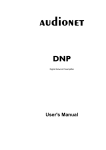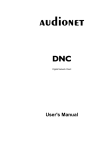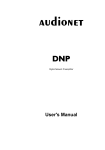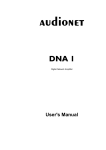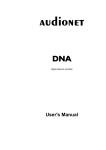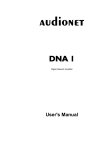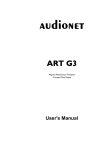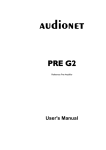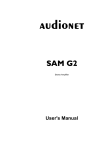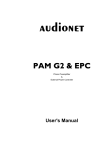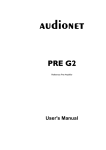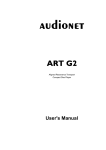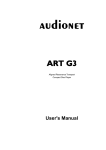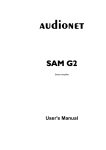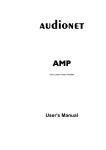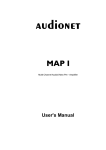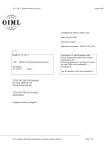Download DNC manual eng - Servi-Q
Transcript
Digital Network Client User's Manual Contents 1 Preface ............................................................................... 7 1.1 Included........................................................................................ 8 1.2 Transport ..................................................................................... 8 2 Overview front panel......................................................... 9 3 Overview back panel....................................................... 10 4 Installation and power supply........................................ 11 4.1 Placement ................................................................................... 11 4.2 Mains connection....................................................................... 11 4.3 Orientation of mains plug......................................................... 12 5 Inputs and outputs .......................................................... 13 5.1 Audio inputs............................................................................... 13 5.1.1 Digital input ................................................................................ 13 5.1.1.1 Audionet HighBit input .............................................................. 13 5.2 Audio output .............................................................................. 14 5.3 Other connections ..................................................................... 14 5.3.1 Network, USB, WLAN ............................................................... 14 5.3.2 USB Audio .................................................................................. 14 5.3.3 FM Antenna Connection ............................................................. 15 5.3.4 Audionet Link ............................................................................. 15 5.3.5 External power supply EPS G2 ................................................... 16 5.3.6 Additional earth connection ........................................................ 17 5.3.7 Control connections .................................................................... 17 6 Usage ............................................................................... 18 6.1 Basic operations......................................................................... 18 6.1.1 Powering up ................................................................................ 18 6.1.2 Switching on and off ................................................................... 19 6.1.3 Mains phase detection ................................................................. 20 6.1.4 Using Audionet Link ................................................................... 21 6.1.5 Control elements on the front panel ............................................ 21 6.2 Detail operations ....................................................................... 22 6.2.1 Display ........................................................................................ 22 6.2.1.1 Digital input channel ................................................................... 22 6.2.1.2 FM tuner ..................................................................................... 22 6.2.1.3 NET input.................................................................................... 23 6.2.2 Input selection ............................................................................. 25 6.2.3 FM tuner ...................................................................................... 26 6.2.4 NET input .................................................................................... 26 6.2.4.1 6.2.4.2 6.2.4.3 6.2.4.4 Internet radio ............................................................................... 26 USB ............................................................................................. 27 iPod ............................................................................................. 27 UPnP server ................................................................................ 28 6.2.5 USB Audio .................................................................................. 28 7 Audionet system remote control .................................. 29 7.1 Key assignment DNC ................................................................ 31 7.2 Screen 1 ...................................................................................... 32 7.3 Screen 2 ...................................................................................... 33 7.4 Screen 3 ...................................................................................... 33 7.5 Screen 4 ...................................................................................... 34 8 Device setup.................................................................... 35 8.1 Overview device menu .............................................................. 36 8.2 Global setup ............................................................................... 37 8.2.1 Display ........................................................................................ 37 8.2.2 Auto start ..................................................................................... 38 8.2.3 Power-off mode ........................................................................... 39 8.2.4 Channel name .............................................................................. 39 8.2.5 Digital equalizer setup................................................................. 40 8.2.6 Trigger out ................................................................................... 41 8.2.7 Speaker distance .......................................................................... 42 8.3 Network setup ............................................................................ 43 8.3.1 Manage Network ......................................................................... 44 8.3.1.1 Restart Network Driver ............................................................... 44 8.3.1.2 Save & Apply Settings ................................................................ 44 8.3.1.3 Load Factory Defaults................................................................. 45 8.3.2 Connection Type ......................................................................... 46 8.3.3 DHCP .......................................................................................... 46 8.3.4 IP Address ................................................................................... 47 8.3.5 IP Mask ....................................................................................... 47 8.3.6 Gateway....................................................................................... 48 8.3.7 DNS ............................................................................................. 48 8.3.8 RCP port ...................................................................................... 49 8.3.9 Wireless setup ............................................................................. 50 8.3.9.1 SSID ............................................................................................ 50 4 8.3.9.2 8.3.9.3 8.3.9.4 8.3.9.5 8.3.9.6 Wireless security ......................................................................... 51 WPA pass phrase ........................................................................ 52 WEP authentication .................................................................... 52 WEP key index ........................................................................... 53 WEP key 0-3 ............................................................................... 54 8.3.10 Example for Network setup ........................................................ 55 8.4 User settings ............................................................................... 59 8.4.1 Save user setting.......................................................................... 59 8.4.2 Load user setting ......................................................................... 59 8.5 Device info .................................................................................. 60 9 Additional information .................................................... 61 9.1 Glossary...................................................................................... 61 9.2 Link collection ........................................................................... 63 9.2.1 Wireless security ......................................................................... 63 9.3 Equalizer filter type .................................................................. 64 9.3.1 Peak-Filter ................................................................................... 64 9.3.2 High shelf filter ........................................................................... 64 9.3.3 Low shelf filter ............................................................................ 64 9.3.4 High-pass filter 2nd order ............................................................. 65 9.3.5 Low-pass filter 2nd order ............................................................. 65 9.3.6 High-pass filter 1st order.............................................................. 65 9.3.7 Low-pass filter 1st order .............................................................. 65 9.4 Error handling (FAQ) .............................................................. 66 9.5 Security advice........................................................................... 67 9.6 Factory defaults ......................................................................... 68 9.7 Specifications ............................................................................. 69 5 1 Preface The Audionet Team congratulates you on your purchase of this unit. Audionet components are no marketing products, they are authentic. Conceived and developed with scientific inspiration, professional engineering expertise and a passion for achieving the perfect sound. They are unique creations designed to inspire musical enjoyment and have an excellent reputation amongst all connoisseurs throughout the world. Each and every one of our precision-manufactured devices is individually crafted at our Bochum works by our experienced and passionate workforce. But before you start listening to your new Audionet DNC, please read this manual carefully so you are able to use and enjoy all functions of this unit without drawback on music quality. 1.1 Included Included you will find the following items: · The network client DNC · The user's manual · one standard mains cord · F-adaptor for FM connection · WLAN antenna · Audionet System Remote Control Harmony One 1.2 Transport Important · Please transport the DNC only in the included package. · Always use the provided cloth bag to prevent scratches on the casing · Please allow the DNC to adapt to the climatic conditions in your listening room before you switch on the unit for the first time after transport. 8 9 A USB- power key set key IR remote control receiver Display down key up key 2 Overview front panel 10 16 Balanced output (XLR), right 17 Unbalanced output (Cinch), right 18 Balanced output (XLR), left Serial control port RS232 Trigger output (5 or 12 Volt) Audionet Link input IN Audionet Link output OUT 7 8 9 15 20 15 Digital input no. 1, no. 2, electrical 14 Digital input no. 3, AES/EBU (XLR) 13 FM antenna input 12 USB input 11 USB Audio Input 10 Ethernet connector LAN 6 14 5-pin connector for external power supply EPS 13 5 12 additional earth connector 11 4 10 Marking mains phase 9 3 8 Mains input 7 2 6 Mains switch 5 1 4 2 1 3 21 17 18 19 21 Connector WLAN antenna 20 Digital input no. 4, no. 5, optical 19 Unbalanced output (Cinch), left 16 3 Overview back panel 4 Installation and power supply Important · During connecting and removing of sources or amplifiers to the DNC all units of your audio system have to be switched off to prevent damage of the DNC or any of the other connected units. · Please make sure that all cables are in absolute best conditions! Broken shields or short-cut cables could damage the DNC and/or any other connected unit. 4.1 Placement Important · It is recommended to place the DNC into a high quality rack or onto a stable table. · Do not expose the unit to direct sunlight. · Do not cover the ventilation slots. · Do not place the DNC in close range to heat sources like radiators. · Do not place the DNC on top of other units, especially not on top of power amplifiers, preamplifiers or similar devices that produce heat. Both units could suffer damage from thermal overload. · Do not place other units on top of the DNC. Both units could suffer damage from thermal overload. · Do not use the unit in places where it is exposed to vibrations. · Do not place the unit close to loudspeakers or into the corner of a room where it is exposed to high levels of sonic energy, which might reduce the sound quality of the unit. 4.2 Mains connection The mains input 2 * is on the back panel of the DNC. To connect the device to mains use the included mains cord. If you prefer to use a different power cord make sure that it meets the specifications for your home country. * see numbers in section "3 - Overview back panel" on page 10. 11 Important · The electrical specifications of your home country must meet the electrical specifications printed onto the back panel. · The DNC is a Class I unit and must be earthed. Please ensure a stable earth connection. Phase (hot pin) is marked on the back panel phase 3. · If you connect the mains cord please make sure that the mains switch 1 on the back panel is switched off. · Never pull the mains plug while the DNC is switched on! Before you pull the mains cord off its socket 2 on the back panel, power down the unit to stand-by mode using power key, and switch off the unit using mains switch 1 . Only in cases of extended absence – like vacations – or if massive trouble on the mains power grid is to be expected you should switch off the DNC from the mains using mains switch 1 . Then, to disconnect the unit completely from mains power grid, pull the mains plug. Tip · The use of high quality mains cords can improve sound quality. Ask your local dealer for more information. 4.3 Orientation of mains plug The correct polarization of mains is important for reasons of audio clarity and stability. Please connect the mains cord so that the hot pin of the wall outlet is connected to the pin of the mains input 2 marked phase 3 . Your Audionet DNC is able to detect a wrong polarization of the mains plug during start-up. If the message ► ► Attention: Mains phase incorrect ◄ ◄ appears in the display, switch off the unit and flip the mains plug in the wall outlet (see section "6.1.3 - Mains phase detection" on page 20). 12 5 Inputs and outputs Important · During connecting and removing sources or amplifiers to the DNC all units of your audio system have to be switched off to prevent damage of the DNC or any of the other connected units. · Please make sure that all cables are in absolute best conditions! Broken shields or short-cut cables could damage the DNC and/or any other connected unit. 5.1 Audio inputs 5.1.1 Digital input Connect your digital sources to the electrical (coaxial) digital input IN 1 and IN 2 15 * or to the optical (TosLink) digital input IN 4 and IN 5 20 . In addition, there is a XLR socket IN 3 AES/EBU 14 for connecting AES/EBU input signals. 5.1.1.1 Audionet HighBit input In order to send audio data across the Audionet HighBit interface to your DNC, connect your source device (e.g. ART G3 or VIP G3) with two digital cords to the digital inputs IN 1 and IN 2. The following table shows how to connect Audionet HighBit-capable devices to the DNC: Audionet HighBit Devices VIP G3 ART G3 Output DNC Input Digital OUT 1 ’ Digital IN1 Digital OUT 2 ’ Digital IN2 Digital OUT 1 ’ Digital IN1 Digital OUT 2 ’ Digital IN2 Important · Only if both connections are established and Audionet HighBit mode is activated on your source device, you can transmit audio data with all sampling rates and full resolution. * see number in section "3 - Overview back panel" on page 10. 13 Note · Check the corresponding section in user's manual for Audionet ART or VIP. User's manuals are available for download on our website www.audionet.de. 5.2 Audio output The DNC is equipped with two pairs of analog outputs: BALANCED OUT 16 and LINE OUT 17 for the right channel, and BALANCED OUT 18 and LINE OUT 19 for the left channel. 5.3 Other connections 5.3.1 Network, USB, WLAN The Ethernet port LAN 10 is a standard RJ45 socket for network cables (Cat-cable, 10/100 Mbit BASE-T). The WLAN port WLAN 21 uses a SMA connection to attach the provided WLAN antenna. With the articulated joint the antenna can be turned into two directions. The USB port USB 12 is a TYPE-A socket (USB 2.0) for external hard drive, USB sticks, iPod, iPad etc. Note · We recommend using a wired network connection for best data transfer rate and to provide high stability in control with our software. 5.3.2 USB Audio The USB Audio port USB AUDIO 11 is a USB TYPE-B-socket. With the USB Audio connection you are able to connect your DNC with a USB cable directly to a PC. Thus you can use your DNC as the sound device / playback device for your PC. Playback operates in asynchronous mode, that means the DNC uses its own clock and you are able to enjoy your music without diminishing sound quality. For using USB Audio the required driver needs to be installed on your PC. For Apple devices using Mac OS X 10.6.4 and higher a suitable driver is included within the operating system. To receive the driver for Windows based systems please contact us via [email protected]. Note · The driver is packed into a zip-file. To install the driver unpack the zip-file into a folder of your choice. Then open the chosen folder and start the installation process executing the file setup.exe. 14 · During the installation process all occurring security warnings can be confirmed with 'OK'. · During the installation process your Audionet device has to be connected with your PC via an USB cable. · After successful installation you can choose your DNC as the sound device / playback device of your PC. For configuration open the system preferences of your PC. · Pay attention to the length of the USB cable. If the cable is too long you might diminish sound quality and / or experience dropouts during playback. 5.3.3 FM Antenna Connection Your device has an F-series connector 13 for antenna connection. An adaptor to coaxial socket is delivered separately. This port is specified for 75 Ohm FM antenna or analog cable TV connection. 5.3.4 Audionet Link For your convenience, the DNC can be switched on/off by other Audionet units (e.g. power amplifiers) connected via Audionet Link by a simple touch on the remote control or the power key on the front panel. You only need a simple optical TosLink cable. Connect the Audionet Link input Link IN 8 of your DNC to the Audionet Link output of the controlling unit. The DNC is equipped with an Audionet Link input Link IN 8 and an Audionet Link output Link OUT 9 . The DNC is a slave device. Connect the Audionet master device to Link IN 8 , other Audionet slave devices can be connected to Link OUT 9 . Thus the switching signal will be passed along. Tip · Audionet source units and power amplifiers are usually equipped not only with an Audionet Link input, but additionally with an Audionet Link output to connect further Audionet devices to be controlled via Audionet Link in a daisy chain. Connect this Audionet Link output to the Audionet Link input of the next Audionet unit using a simple optical TosLink cable allowing you to switch on/off your complete Audionet system by your Audionet master unit. Important · For the DNC to be controlled via Audionet Link, menu item Poweroff mode within the Global Setup menu has to be set to Quick Start (see section 8.2.3 - Power-off mode on page 39). 15 5.3.5 External power supply EPS G2 In order to use the optional external power supply Audionet EPS G2 (External Power Supply) connect it with delivered cable to equal socket EPS 5 on the back panel of your DNC. Connect both (!!) units (DNC and EPS G2) to mains. First, switch on the EPS on its back panel. Then switch on the DNC with the mains switch 1 . Now the DNC is ready to use (stand by mode). Switch on the DNC with the power key on the front panel or keys Power On or Power Toggle of the Audionet System Remote Control Harmony One. The Audionet EPS G2 will then be automatically switched on time-delayed. To disconnect the DNC and EPS G2 from mains, switch the DNC into stand-by mode. Use the power key on the front panel or the keys Power Off or Power Toggle on the system remote control. First, switch off the DNC with the mains switch 8 on the back panel, and then switch off the EPS G2. Now you can disconnect the mains and EPS G2 connection cables. Important · Never switch on or off the EPS G2 on its back panel while the DNC is operating! · The DNC is only to be used with EPS G2 from serial number 12.23.10 on up. For EPS or EPS G2 with older serial numbers there is no guarantee for proper functionality! · Before using the DNC in combination with the external power supply EPS G2 please read the user's manual of the EPS G2 carefully! 16 5.3.6 Additional earth connection An optional green-yellow cord for the additional earth connection is available from Audionet. Attach this cord to the earth connector 4 on the back panel of the DNC and put the plug into the mains socket right beside the mains cord of your DNC. This ensures an additional and stable earth connection resulting in a better sound. 5.3.7 Control connections Use trigger output TRIGGER 7 to control (e.g. switch on/off) non Audionet devices. If you switch on the DNC from stand-by mode, the trigger output 7 provides a signal of 12 Volts DC (see section "8.2.6 Trigger out" on page 41), which can be re-configured to 5 Volts DC. The serial connection RS232 6 is an additional control port to your DNC e.g. for house automation systems (Crestron or the like). Tip · Use a 3.5 mm telephone mono plug to connect a device to the trigger output 15 of your DNC. The pinning is as follows: Ground 17 Switching Voltage 12V or 5V DC 6 Usage All functions of the DNC are microprocessor controlled. This guarantees highest precision, exclusive functions, easy handling and protection against operating errors. 6.1 Basic operations 6.1.1 Powering up First of all, please make sure your DNC is connected correctly to your signal sources, preamplifier(s) and mains (see section "4 - Installation and power supply" on page 11 and "5 - Inputs and outputs" on page 13). The DNC is a stand-by unit. Please operate the mains switch 1 on the back panel. The display shows a welcome message for a brief moment. After that the DNC is in stand-by mode. Only in cases of extended absence (like vacations) or if massive trouble on the mains power is to be expected (e.g. thunder storms) it is recommended to disconnect the DNC from the mains. While the DNC is in stand-by mode, operate mains switch 1 on the back panel. The display will go dark. To disconnect the DNC from mains completely, you have to pull the mains cord off the mains jack 2 . Important · Before you switch off the DNC from mains, power down and discharge completely all units connected to the outputs of the DNC. 18 6.1.2 Switching on and off To power up the DNC from stand-by mode, press the power key on the front panel. The DNC issues the message: Waking up ... In case the mains plug has the incorrect polarization a warning will appear in the display (see section "4.3 Orientation of mains plug" on page 12). After that the unit is in normal operating mode and ready to use. If you would like to switch off the unit, please press the power key on the front panel. The display shows the message Going to sleep ... and the unit enters stand-by mode. Note · Of course, you may switch on/off the DNC with the Audionet System Remote Control Harmony One. For detailed information please refer to section "7.5 - Screen 4" on page 34. 19 6.1.3 Mains phase detection The correct polarization of mains is important for reasons of audio clarity and stability. Please connect the mains cord with the hot pin of the wall outlet to the pin marked phase 3 of the mains input 2 on the back panel. The DNC recognizes the incorrect polarization of the mains plug automatically. Right after switching on the unit from stand-by mode by pressing the power key on the front panel the following message will appear in the display in case the mains polarization is incorrect: ► ► Attention: Mains phase incorrect ◄ ◄ If you are alerted by the above message, switch off the unit by pressing the power key. Please wait until the display no longer reads: Going to sleep ... Disconnect the DNC from mains by operating the mains switch 1 . Now pull the mains plug and re-insert it into the mains socket rotated by 180°. If you switch on the unit again, the warning should not appear now. Important · If the DNC issues the mains polarization warning or no warning at all for both positions of the mains plug, check the connection to earth of your mains socket and mains cord. You have to ensure a stable connection to earth for the mains phase detection of the DNC to work correctly! 20 6.1.4 Using Audionet Link The DNC is equipped with an Audionet Link input Link IN 8 and an Audionet Link output Link OUT 9 allowing you to connect further Audionet units (e.g. preamplifiers, power amplifiers or CD player) via Audionet Link (also see section "5.3.4 - Audionet Link" on page 15). If the rest of your Audionet system is connected to your DNC via Audionet Link, all forth following linked units will be automatically switched on/off as soon as the DNC itself is switched on/off via Link IN 8. Note · Please read section "5.3.4 - Audionet Link" on page 15. Also, consult the user's manual of your Audionet components connected via Audionet Link for further information. · If you use Audionet Link to switch off other devices, please wait until everything is in stand-by mode before you switch on again. Important · For the DNC to be controlled via Audionet Link, menu item Poweroff mode within the Global Setup menu has to be set to Quick Start (see section 8.2.3 - Power-off mode on page 39). 6.1.5 Control elements on the front panel The front panel has four keys to control the DNC (see section "2 Overview front panel" on page 9). With these keys you can control all functions as well as all setup options to adjust the unit to your preferences (see section "8 - Device setup" on page 35). power Use key to switch on/off the unit (see section "6.1.2 Switching on and off" on page 19). set Push key shortly to change input channel (see section "6.2.2 - Input selection" on page 25). Within a menu press shortly to open a subfolder or to confirm and save an adjustment. Push the key for longer than two seconds to get into system menu (see section "8 - Device setup" on page 35). Within a menu press long to step back and open the superior folder or to dismiss an adjustment without saving. down Push key to select previous input channel (see section "6.2.2 - Input selection" on page 25) or change an option of the setup menu (see section "8 - Device setup" on page 35). up Push key to select next input channel (see section "6.2.2 - Input selection" on page 25) or change an option of the setup menu (see section "8 - Device setup" on page 35). 21 6.2 Detail operations 6.2.1 Display The display provides the following information in the normal operating mode. Depending on which channel you chose, you get different information. If there is more information to show you can switch display pages with the Info key on system remote control Harmony One (see section "7.1 Key assignment DNC" on page 31). You will need it especially for the NET input channel (see section "6.2.1.3 - NET input" on page 23). The following illustrations will show you the differences between the input channels. Your display could be different, because of your selected system adjustments. 6.2.1.1 Digital input channel Digital In 1 D1 Input PCM 44 kHz Channel name Signal handling 6.2.1.2 FM tuner FM Radio MHz FM Input 99.2 Channel name 22 Frequency 6.2.1.3 NET input · View 1: Channel name PCM Streaming In EQ NET 44 kHz Equalizer · Input Signal handling View 2: Marker Media devices and internet radio Marker position ► Internetradio USB UPnP Server 1 of 4 23 ◄ Folder icon · View 3a (Play from UPnP or USB): Title Interpreter Ludwig van Beethoven Für Elise WoO 59 ► 00:00:01 Play state Play/Stop/Pause Album · mp3 Media type View 3b (Play from internet radio station): Title/Interpreter Station text Station name WDR Event Track name ► Play state Play/Stop/Pause mp3 128 kbps Data type Data rate 24 Play time 6.2.2 Input selection Push the set key on the front panel once for less than two seconds to enter the input selection menu. Then select the desired input channel with the keys up and down. In the display you see the selected input channel, channel number and your chosen channel name. Press set to apply the channel switching. Overview of DNC input channels: Signal see 3 - Overview back No. Inputs 1 D1 Digital (electrical) Digital Inputs IN 1 15 2 D2 Digital (electrical) Digital Inputs IN 2 15 3 D3 Digital (AES/EBU) Digital Inputs IN 3 14 4 D4 Digital (optical) Digital Inputs IN 5 20 5 D5 Digital (optical) Digital Inputs IN 6 20 6 NET Stream, USB, Internet radio Network 10 12 21 7 USB USB Audio In USB Audio 11 8 FM FM Tuner FM Antenna 13 panel on page 10 While switching of inputs, the outputs are switched off at first. Once an input is selected, the outputs are switched on again. Note · Leave the input selection function by holding down the set key longer than 2 seconds or wait a few seconds. · Using the Audionet System Remote Control Harmony One, select an input channel by simply pressing the corresponding key, or use the keys Ch+ and Ch- to switch to the next or previous input channel without using the Select Input function. 25 6.2.3 FM tuner For setting and saving radio stations to your DNC, please use the software Audionet RCP (see chapter "7 - FM-Tuner" on page 23 in RCP user's manual). You can also setup your radio station frequency manually with your remote control. Use the keys of the Audionet System Remote Control Harmony One (see section "7.1 - Key assignment DNC" on page 31). Use keys Page Up / Page Down to change frequency manually. Use keys up / down of the directional pad to change presets, press keys left / right to start an automatic station scan. 6.2.4 NET input Marker Media devices and internet radio Marker position ► Internetradio USB UPnP Server Folder icon ◄ 1 of 4 6.2.4.1 Internet radio With the internet radio service vTuner it is possible to select your favourite radio stations from a steadily growing number of worldwide stations. You have to register with an account at vTuner to save your favourite stations and to receive personalized recommendations. Beforehand a stable network environment should be set up for your Audionet device (see section "8.3 - Network setup" on page 43). To register an account, open the website http://audionet.vtuner.com. You will be going to visit this address every time you wish to edit your favourite radio stations. As long as you do not have registered an account with your Audionet device, you have to click on Register Here right below the login. Additionally you will be requested to enter your E-Mail address, to choose a personal passphrase and to enter an access code. There a two possibilities to spot your access code. With the system remote control Harmony One select the NET input. Select the first menu item Internet Radio (1 of 5) using OK key. Navigate to menu entry Get Access Code (13 of 14). Confirm with OK . Your access code consists of eight digits and is now shown in line 3 (3 of 3). Note down this code and enter it in the registration window within your browser. 26 6.2.4.4 UPnP server The easiest way to play music from an UPnP server is to use the software Audionet RCP or Android App aMM. Note · Look out for separately available user's manual to our software Audionet RCP. You can find it on our website www.audionet.de. If you want to use your System Remote Control Harmony One, it is the same way to navigate through as shown above in section internet radio and USB. 6.2.5 USB Audio The USB Audio connection allows a direct connection of your DNC to your PC. Audio files can then be played with your favorite software. The DNC serves as sound device / playback device. For further information see section "5.3.2 - USB Audio" on page 14. 28 7 Audionet system remote control Every function of the DNC is accessible via the Audionet system remote control Harmony One. Additionally, up to 14 other devices can be controlled by the Harmony One. Press Devices key to enter Device Mode. The display now lists all devices included in the current configuration of the Harmony One. Select DNC from the list to set the Harmony One to controlling the DNC. The Device Mode gives you access to all the possible commands to control your DNC. The following explains all these commands in detail. Important · During everyday use, you should never need to use the Device Mode of your Harmony One, but control the DNC (and other devices of your audio setup) by customizing your Activities. For detailed information on how to customize and use Activities on your Harmony One please consult the separate user's manual for Harmony One. It is available for download on our website www.audionet.de. 1 2 My Activities: Mi 14:51 1/2 pages Listen to CDs Watch a DVD 3 3 CD with VIPG3 Options Devices 4 5 1. Power key for use with Activities, turns all devices off that are included into the current Activity. See separate user's manual for Harmony One. 2. Depending on the operational mode, the touch screen of the Harmony One shows a list of Activities or Devices, help or infrared commands and any available listings. 3. If a menu or listing stretches over more than one screen page, use the corresponding arrow buttons to go to the next or previous page of the menu or listing (see also separate user's manual for Harmony One). 4. Devices key, lists all the devices on the display, and allows you to select and directly control any device included in the configuration of the remote control (see separate user's manual for Harmony One). Select DNC to enter Device Mode for controlling the DNC. 29 5. Activities key: Press this key to view a list of Activities you have added. Press the button next to the Activity you want to select, and the Harmony One will control your entertainment system (see separate user's manual of Harmony One). Important · The Power key is only available for Activities. In Device Mode the Power key has no function. · Even without using an Activity, the user is able to control all functions of the DNC using the Harmony One in Device Mode. · The keys described below to control the DNC refer to the factory default programming of the Audionet System Remote Control Harmony One. Understandably, any changes done to this setup by the user cannot be discussed here. Tip · In order to switch the DNC on/off, without using an Activity, please use the keys Power On , Power Off or Power Toggle on screen 4 (see section "7.5 - Screen 4" on page 34). Of course, it is possible to control the DNC without any Activity, but to tap the full potential of the Harmony One you need to configure Activities customized to your needs (please refer to separate manual of the remote control Harmony One). Note · Please read the separate user's manual to your Audionet System Remote Control Harmony One. Activities, Devices and Device Mode as well as customizing the remote control are discussed there. It is available for download on our website www.audionet.de. 30 7.1 Key assignment DNC DNC Mi 14:51 1/5 pages Digital Input 1 Digital Input 2 Digital Input 3 Optical Input 4 Optical Input 5 Streaming Input Current Activity Devices 1 3 2 4 5 6 7 8 1 Use Menu key to navigate through the setup menus. This key has the same function as set key on the front panel (see section "8.2 Global setup" on page 37). 2 Exit leaves every menu to go back to main screen. If you are in a submenu of the NET input you will get to the top level. 3 Page up/down. With this key you can switch three files or folders forward/backward. The key is activated only if you select NET input (Internet radio, UPnP play, USB and iPod). 4 Ch+ switches to the next input channel (see section "6.2.2 - Input selection " on page 25). 31 5 Ch- switches to the previous input channel (see section "6.2.2 Input selection " on page 25). 6 Cancel to step back in menu, without saving any changes 7 Player keys for controlling media content if you chose NET input. 8 Numeric keys are used for input of numbers or letters (SMS principle) if the menu item supports direct letter input. Note · To navigate backwards in menu use Cancel 6 , or leave the setup menu using Exit 2 . 7.2 Screen 1 DNC Mi 14:51 1/4 pages 1 Digital Input 1 Optical Input 1 4 2 Digital Input 2 Optical Input 2 5 3 AES/EBU Input Current Activity Devices 1 Directly selects input channel D1 (coaxial). 2 Directly selects input channel D2 (coaxial). 3 Directly selects input channel D3 (AES/EBU). 4 Directly selects input channel D4 (optical). 5 Directly selects input channel D5 (optical). 32 7.3 Screen 2 DNC Mi 14:51 2/4 pages 2 Streaming Input 1 FM Radio 3 USB Audio Input Current Activity Devices 1 Directly selects input channel NET (streaming input). This input channel allows you to access internet radio stations, USB devices, iPod and UPnP server (if they are connected). 2 Directly selects input channel USB (USB Audio In). 3 Directly selects input channel FM radio. 7.4 Screen 3 DNC Mi 14:51 3/4 pages 2 Random 1 Repeat 3 Equalizer on/off Current Activity Devices 1 Random activates random play from selected folder (activated only with NET input). 2 Equalizer on/off switches on/off the equalizer for the selected channel. 3 Repeat activates repeat for titles of a folder ALL or for the currently playing title ONE (activated only with NET input). 33 7.5 Screen 4 DNC Mi 14:51 4/4 pages 2 Power On 1 Power Off 3 Power Toggle Current Activity Devices 1 If the DNC is in stand-by mode, press key Power On to switch the unit on. 2 Use Power Toggle to switch on/off the DNC. This key has the same function as the power key on the front panel. If the DNC is in stand-by mode, Power Toggle switches on the unit. If the DNC is already switched on, Power Toggle switches off the unit to standby mode. 3 If the DNC is switched on, use key Power Off to switch the unit off to stand-by mode. 34 8 Device setup To adjust the DNC to your preferences, please use the setup menu. You can control the menu with the keys on the front panel of your DNC or with your remote control. For more comfortable adjustment use our software Audionet RCP. You only need to integrate your DNC to your network (see section: "8.3.10 - Example for Network setup" on page 55). To control your DNC with front panel keys, use set, up and down. set holding the key pressed for more than 2 seconds opens the system menu. If you hold again you leave the menu without saving, you cancel. Short push saves/applies a menu item or switches into marked menu item. up, down are used to select setup menu items and change. For easier control you can use the directional pad on your System Remote Control Harmony One (see section "7 - Audionet system remote control" on page 29). To setup your DNC very comfortable, please use our software Audionet RCP. You can control everything with mouse and keyboard. You can see everything on your computer display. Especially with equalizer setup it is very useful, because you have a good overview (see also Audionet RCP user's manual). Note · Changes will only take effect if you push OK on your remote control or short push of set key on DNC front panel. · Within menus with more than one page the fastest way to reach the last entries is to press up. To reach, for example, entry 9 of 9, open the main menu (marker 1 of 9) and press up once instead of pressing down several times. Use the same procedure with keys Up / Down on the directional pad of the Audionet System Remote Control Harmony One. 35 8.1 Overview device menu Global Setup Function Display Setup display brightness Auto start Setup auto start mode Power-Off Mode Setup stand-by mode Channel Name Name the input channel (12-digits) Digital EQ Setup Setup the parametric 5-band-equalizers (separately for each channel) Trigger Out Setup Trigger Out for control of non Audionet devices (e.g. active subwoofer) Speaker Distance Setup distance between speakers and hearing position Network Setup Manage Network Manage main network setup Connection Type Select type of connection DHCP Switch on/off DHCP IP Address Setup IP address for your DNC IP Mask Setup subnet mask Gateway Setup gateway IP address DNS Setup DNS IP address RCP Port Setup network port for software Audionet RCP Wireless Setup Setup Wi-Fi (SSID, crypt,…) Save User Setting Load User Setting Device Info 36 8.2 Global setup 8.2.1 Display Adjust the display brightness with the front panel keys or your system remote control Harmony One. Brightness adjustment Title ► Scale SET DISPLAY BRIGHTNESS --------------+ Off 25% 50% 75% ◄ 100% Note · Get to this option at anytime opening the Global Setup and navigating to Display. Use directional pad or up / down to select desired brightness. · It is also possible to set display brightness with the software Audionet RCP. · Is the brightness set to Off the display is only on during setup. It switches off automatically several seconds after the last user entry. · The DNC activates the display saver automatically 12 minutes after last user entry/activity. · During active display saver, the display shows only the number of the selected input channel NET, for example. The display brightness is always reduced to 25%, and the location of the information text will change randomly every 12 seconds to prevent any burn-in effect of the display. · The display saver is deactivated, and the display returns to its normal mode as soon as any user entry is detected · The user cannot switch off the automatic display saver function! Important · Long-term usage of the display set to maximum brightness (setting 100%) may cause extended signs of wear resulting in a decay of contrast or brightness of individual dots in the display. Do not use the display with a brightness set higher than the factory default of 50% for a longer period of time! 37 8.2.2 Auto start Auto start adjustment Title ► SET AUTO START ◄ Auto Start is disabled disabled The Auto Start function is disabled. After switching on the mains switch 1 on the back panel, the DNC enters the stand-by mode. You have to use the power key on the front panel or Power On or Power Toggle keys on the Audionet System Remote Control Harmony One to switch on the unit into normal operating mode*. active The Auto Start function is active. As soon as you connect the DNC to mains (i.e. use the mains switch 1 on the back panel) the unit starts up automatically to normal operating mode. Use this setting for timer controlled operations. * or switched on/off by Activities on the Audionet System Remote Control; see separate user's manual Harmony One 38 8.2.3 Power-off mode Power-off adjustment Title ► SET POWER-OFF MODE ◄ normal The DNC differentiates between two power-off modes. Firstly the normal power-off mode and secondly the Quick Start mode. The factory default setup is the normal mode, because of low power consumption in stand-by (less than 1W). If you use normal power mode, you cannot switch on the DNC with the software Audionet RCP or with Audionet Link. With the Quick Start mode activated, the network interface remains activated, and the DNC start up process is accelerated, because the network interface must not boot up. Furthermore you can use software Audionet RCP or Audionet Link to switch on the DNC. If you select Quick Start mode the power consumption is increased. Check out "9.7 - Specifications" on page 69. 8.2.4 Channel name Assigned channel name Title ► Input number EDIT CHANNEL NAME ® Analog In 1 ◄ AN 1 You can assign a fully user-definable name up to 12 characters in length to each of the eight input channels. The display shows the number of the currently selected input channel and the assigned channel name. The cursor marks the character you now may alter. 39 Note · For easier adjustment of the channel name use the software Audionet RCP (see user's manual RCP). · All settings apply to the currently selected input channel. 8.2.5 Digital equalizer setup The digital EQ is a parametric 5 band equalizer with separated adjustment for left and right channel. Channel L/R, Sub 1, 2 Marker ► SET DIGITAL EQUALIZER ► Left ◄ Freq: 120 HZ Gain: 3.0 dB Frequency Band selection EQ 1-5 Title ◄ EQ 1 Q: 8.00 Peak EQ Gain Filter type Quality factor You can navigate through the menu of the digital EQ with the directional pad on your system remote control. With up/down keys you choose the parameter for adjustment, left/right changes the selected parameter. If you enter the digital equalizer menu item, the first selected parameter is Left. Here you select the speaker channel you want to adjust [Left, Right]. ► SET DIGITAL EQUALIZER Left Freq: 120 HZ Gain: 3.0 dB ◄ ► EQ 1 ◄ Q: 1.00 Hi Shelf Secondly you select the band [EQ 1 – EQ 5]. For each band you can adjust the following parameter: Freq center- respectively cutoff frequency (depends on filter) Q filter quality (depends on filter) Gain gain (from -12 dB to +6 dB) Filter type you can choose between seven different filter types 40 Filter type Short description Peak EQ band-pass filter Hi Shelf treble control Lo Shelf bass control LP 2nd low pass filter 2nd order HP 2nd high pass filter 2nd order LP 1st low pass filter 1st order HP 1st high pass filter 1st order Note · For easier adjustment of equalizer parameters use the software Audionet RCP (see user's manual RCP). · All settings apply to the currently selected input channel. 8.2.6 Trigger out Adjustment Title ► SET TRIGGER OUT ◄ Trigger Out: disabled The trigger out connection could be used to remotely switch on/off non Audionet devices. By factory default the voltage is adjusted to 12V DC. If necessary the output voltage can be re-configured to 5V DC. Changing the voltage must be done by authorized personnel only. Ask your local dealer for support. Note · All settings apply to the currently selected input channel. 41 8.2.7 Speaker distance Speaker distance left Speaker distance right Title ► SET SPEAKER DISTANCES ► Left Right : : 0 cm 0 cm ◄ ◄ 1 of 2 Use this menu to enter the distances from your speakers to your listening position. The distance ranges from 0 to 700 cm in steps of 5 cm. According to the entered distances, the DNC calculates the necessary delays of each channel to ensure that all signals from all speakers arrive at the same time at the listening position. 42 8.3 Network setup Marker Network adjustment Marker position ► Network Profile DHCP IP Address Key icon ◄ 1 of 8 Your DNC is set to receive DHCP* information from your network. If you connect your device to a wired network, it should be ready to use. For use of fixed IP address you may contact your network administrator to get the information you need to adjust. Use your system remote control Harmony One to adjust your IP and Wi-Fi information. An adjustment with the front panel keys is possible. To set numbers for an IP address you can use the numeric key pad. For letters you can use the numeric key pad as well (SMS principle) or you navigate with the directional key pad. With up/down you change the letter and with left/right you move the cursor. Confirm your input with OK key. An example for network configuration can be found at the end of the section (see section: "8.3.10 Example for Network setup" on page 55). Most network terms are defined in glossary (see section: "9.1 - Glossary" on page 61). Note · Wireless setup can also be done with the software Audionet RCP. For the time of configuration you need to connect your DNC to the wired network. Later you may disconnect the cable for using a Wi-Fi connection. · Every block of an address consists of three numbers. Sometimes the triplets are not written down in full length. If that is the case with an address you need for your network setup, then the leading zeros have been left out. You need to complete these addresses for use with your DNC referring to the following example: e.g. 0.1.10.100 has to be completed to 000.001.010.100. * see section: "9.1 - Glossary" on page 76 43 8.3.1 Manage Network Save and Apply Settings Driver Restart Title ► Manage Network Restart Network Driver Save & Apply Settings Load Factory Defaults ► ◄ ◄ Factory Defaults In this menu you find the basic setup for managing the network preferences of your DNC. The following explains the menu in detail. 8.3.1.1 Restart Network Driver Sometimes it might be necessary to restart the network driver of the DNC. With this function you can restart the driver without having to switch the device off completely. The driver restarts with its current settings. Select this menu entry and confirm your selection with OK . The DNC issues the following message: ► re-starting network… ◄ It takes about 30 seconds for the driver to be restarted. Then your Audionet device will be available in the network again. 8.3.1.2 Save & Apply Settings This entry has to be selected every time you finished network configuration and want to save and apply the new values. Made changes to your network setup will be dismissed without saving and applying them unless you select this particular entry. Select this menu entry and confirm your selection with OK . It takes about 30 seconds for the driver to be restarted. Then your Audionet device will be available in the network again. Note · You have to execute this entry if you want to save and apply your made changes. Otherwise your configuration will be dismissed! 44 8.3.1.3 Load Factory Defaults With this function you can restore the factory settings of your DNC's network driver. The DNC is factory-set to wired ethernet connection with DHCP activated. This way, if you connect your device to a wired network, it should be ready to use. Select this menu entry and confirm your selection with OK . The factory default settings are now loaded. After successfully loading the factory defaults the cursor automatically marks the menu entry Save & Apply Settings. This entry has to be executed as described in section "8.3.1.2 - Save & Apply Settings" on page 44 to apply the factory defaults. Note · You have to execute menu entry Save and Apply Settings if you want to save and apply the factory default settings. Otherwise this configuration will be dismissed! · If you accidentally selected this entry and the factory default settings are loaded, you are able to exit the menu with the key Exit of your Audionet System Remote Control Harmony One or by pressing set longer than 2 seconds. This way the settings accidentally loaded will not be activated and your former settings will remain. 45 8.3.2 Connection Type Connection Type Title ► SET CONNECTION TYPE ◄ Wireless (WiFi) 802.11 Wired Ethernet Factory setting. Your DNC connects to a network via a connected network cable. Wireless (WiFi) Your DNC establishes a wireless connection via the included WLAN Antenna. Only if Wireless (WiFi) 802.11 is selected, the menu "8.3.9 Wireless setup" on page 50 is available. 8.3.3 DHCP DHCP adjustment Title ► SET DHCP MODE DHCP : ◄ active disabled DHCP client mode is disabled active Your DNC will try to get information via DHCP. If the IP address is received from DHCP server, the following menu items must not be setup. Menu item IP address, IP mask, gateway and DNS are without effect and they are overwritten by DHCP information. Tip · Use directional pad on your System Remote Control Harmony One. Confirm everything with OK key. 46 8.3.4 IP Address IP Address Title ► SET IP ADDRESS ◄ 192.168.178.222 Setup your chosen IP address. The used address type is IPv4 (e.g. 192.168.178.222). Tip · Use numeric key pad on your System Remote Control Harmony One. Confirm everything with OK key. 8.3.5 IP Mask Subnet mask Title ► SET IP MASK ◄ 255.255.255.000 Setup your used subnet mask (e.g. 255.255.255.000). Tip · Use numeric key pad on your System Remote Control Harmony One. Confirm everything with OK key. 47 8.3.6 Gateway Gateway-IPAddress Title ► SET GATEWAY ADDRESS ◄ 192.168.178.001 Setup your gateway IP address (e.g. 192.168.178.001). Tip · Use numeric key pad on your System Remote Control Harmony One. Confirm everything with OK key. · The gateway address is mostly the same as the router IP address. 8.3.7 DNS DNS IP address Title ► SET DNS ADDRESS ◄ 192.168.178.001 Setup your DNS IP address (e.g. 192.168.178.001). Tip · Use numeric key pad on your System Remote Control Harmony One. Confirm everything with OK key. · The DNS IP address is mostly the same as the router IP address. 48 8.3.8 RCP port RCP port adjustment Title ► SET RCP PORT ◄ RCP PORT: 54321 The communication port for software Audionet RCP and Android App aMM is set up here. This adjustment should only be done by professional users. Setup a value between 50000 to 59999. The default value has to be changed only if you have network communication problems. Ask your network administrator for support. Tip · Use directional pad left/right on your System Remote Control Harmony One. Confirm everything with OK key. 49 8.3.9 Wireless setup Wi-Fi adjustment Marker Marker position ► SSID Wireless Security WPA Cipher Type Key icon ◄ 1 of 10 All Wi-Fi adjustment has to be done manually. You can find all your Wi-Fi adjustments in your router or access point. If you have no access to this information ask your network administrator. Note · You can use software Audionet RCP to adjust Wi-Fi settings. A wired network connection is necessary. This connection can be removed after setup (see user's manual Audionet RCP). 8.3.9.1 SSID Enter your Wi-Fi name. Attention on case sensitive input. SSIDname Title ► SET WIRELESS SSID ◄ WLANNAME - Note · Use numeric key pad on your System Remote Control Harmony One for letter input (SMS principle). You have to switch the cursor position forward manually. Use the left/right keys on directional key pad. Confirm the adjustment with the OK key. · Use key Cancel 9 to delete the selected character. In this case the key Cancel 9 does not execute a step backward. Press Exit to leave the menu without saving. 50 8.3.9.2 Wireless security Select your Wi-Fi crypt type. Take this information from your router. Crypt adjustment Title ► SET SECURITY MODE ◄ WPA2PSK None no crypt type selected (not recommended). WEP Wired Equivalent Privacy, out-dated and unsecure security standard (not recommended). WPAPSK Wi-Fi Protected Access Pre-shared key was an transitional standard to replace WEP until the new WPA2 was defined (not recommended). WPA2PSK Wi-Fi Protected Access 2 Pre-shared key is the regular standard for Wi-Fi security (recommended). Note · Use directional pad left/right on your System Remote Control Harmony One. Confirm everything with OK key. · Wikipedia links to all security terms can be found in section "9.2.1 Wireless security" on page 63. Tip · In the preferences of some new routers / access points the used WPA2PSK crypt type might be called "WPA2PSK – Personal" or "WPA2 – Personal". 51 8.3.9.3 WPA pass phrase Enter your WPA network key. Attention on case sensitive input. This phrase is only active with WPAPSK or WPA2PSK. Wi-Fi security key Title ► SET WPA PASSPHARSE ◄ security_key - Note · Use numeric key pad on your System Remote Control Harmony One for letter input (SMS principle). You have to switch the cursor position forward manually. Use left/right keys on directional key pad. Confirm the adjustment with the OK key. · Use key Cancel 9 to delete the selected character. In this case the key Cancel 9 does not execute a step backward. Press Exit to leave the menu without saving. · The passphrase has to consist of at least 8 characters. Maximum length is 63 characters. The longer the passphrase the more secure the connection. For further information see the documentation of your router / access point. 8.3.9.4 WEP authentication Select the WEP setup to your network. WEP mode Title ► SET WEP AUTHENTICATION open open Open Authentication shared Shared-Key-Authentication 52 ◄ Note · Chose authentication mode with directional pad. Left for open and right for shared. Confirm the adjustment with the OK key. · We strongly recommend to use WPA2PSK standard to secure your Wi-Fi connection. WEP is not secure. 8.3.9.5 WEP key index Select the Index Key 0-3 WEP index Title ► SET WEP INDEX KEY ◄ WEP Key Index: 0 Note · Select the WEP key index with your directional pad left / right. Confirm the adjustment with the OK key. 53 8.3.9.6 WEP key 0-3 Enter the WEP key phrase for key 0 - 3. WEP key Title ► SET WEP KEY 0 ◄ 80ff72ab32 - Note · Use numeric key pad on your system remote control Harmony One for letter input (SMS principle). You have to switch the cursor position forward manually. Use left/right on directional key pad. Confirm the adjustment with OK key. · Use key Cancel 9 to delete the selected character. In this case the key Cancel 9 does not execute a step backward. Press Exit to leave the menu without saving. · A WEP key contains only numbers 0-9 and letters a-f. · A WEP key consists of 10 or 26 digits. 54 8.3.10 Example for Network setup In this sample all adjustments are made with the System Remote Control Harmony One. Compare the keys in this section "7.1 - Key assignment DNC" on page 30. Choose the Device DNC (see section: "7 - Audionet system remote control " on page 29). Open the system menu with the Menu key and mark the menu item Network Setup with the directional pad keys up/down. Confirm with OK key. Channel Setup Delay Manager ► Network Setup ◄ 4 of 7 Switch to menu item Connection Type. Manage Network ► Connection Type DHCP ◄ 1 of 8 With the keys left / right of the directional pad choose your preferred connection type. Connection types Wired Ethernet and Wireless (WiFi) 802.11 are available. Confirm with OK . ► SET CONNECTION TYPE ◄ Wired Ethernet In this sample we suppose that you do not use DHCP in your network. Therefore we disable the DHCP function and set a fixed IP address. Open the menu item DHCP, press the left directional pad to select disabled and confirm with OK key. The DNC saves the adjustment and switches to the Network Setup menu. ► SET DHCP MODE DHCP: disabled 55 ◄ Now you have to enter the IP address you selected for your DNC. (e.g. 192.168.178.222 or 192.168.000.222 or 192.168.001.222). ► SET IP ADDRESS ◄ 000.000.000.000 Insert the IP address directly with the numeric key pad in the lower section on your System Remote Control. Confirm with OK key. The DNC applies the adjustment and switches to the Network Setup menu. ► SET IP ADDRESS ◄ 192.168.178.222 Select the menu item IP Mask and compare the adjustment with your data. The default value 255.255.255.000 should be the same with your network and could be confirmed with OK . Otherwise, enter your settings via numeric keypad. ► SET IP MASK ◄ 255.255.255.000 The gateway in your network is probably the router, so you have to set the routers IP address as gateway address. Enter the address which is correct within your network and confirm. ► SET GATEYWAY ADDRESS 192.168.178.001 - 56 ◄ Mostly the DNS address is the same like the routers IP address. If you use another DNS, enter the DNS IP address which is correct within your network configuration. You can find a DNS address through the internet. Use a search engine to find DNS server addresses for your location. ► SET DNS ADDRESS ◄ 192.168.178.001 With this menu item the section fixed IP address is completed. When you use your DNC in a wired network, the network setup is completed. You can now save and apply your adjustments. If you want to use a Wi-Fi connection skip to paragraph "Wi-Fi adjustment". Save network profile Within the menu item Manage Network select Save & Apply Settings and confirm with OK . The new created network profile with all its settings is now saved and will immediately be applied. Wi-Fi adjustment Within the menu Manage Network select entry Connection Type. Now change to Wireless (WiFi) 802.11 and confirm with OK . Back in Network Settings the menu item Wireless Setup is now available. Now you have to enter the network name and network security key. Maybe you have to ask your network administrator or check out your router configuration. ► SSID Wireless Security ◄ 1 of 2 Note · In menu Connection Type the adjustment Wireless (WiFi) 802.11 has to be made. Otherwise menu entry Wireless Setup is not visible. 57 Select SSID and set the network name. ► SET WIRELESS SSID ◄ Audionet_WLAN You have to be attentive to case sensitive input. Use the numeric key pad (SMS principle) for numbers and letters. With the left/right keys of the directional pad you switch to the next input position. The cursor does not step forward automatically. Confirm your input with OK . Now select your security mode. ► SET SECURITY MODE ◄ WPA2PSK You can choose between WEP, WPAPSK and WPA2PSK. All settings have to be confirmed with OK key. Because the WEP mode is not secure, we only describe the setup of WPA security mode. At last insert your Wi-Fi security key into menu item WPA Pass Phrase. Sample: 1x2y3z4a5b ► SET WPA PASSPHRASE ◄ 1x2y3z4a5b Confirm your input with OK .If all your network adjustments are correct now your settings can be saved. Save network profile Within the menu item Manage Network select Save & Apply Settings and confirm with OK . The new created network profile with all its settings is now saved and will immediately be applied. 58 8.4 User settings You can store 20 separate user settings to your DNC. This function can be selected with the keys on the front panel and with the System Remote Control Harmony One. Furthermore you can use the software Audionet RCP (see Audionet RCP user's manual). A user setting contains all information which is currently set, i.e. all EQ adjustments for all channels, also speaker setup (e.g. subwoofer active). Example for usage: Store a user setting with less bass; you may call it "night mode". 8.4.1 Save user setting ► SAVE USER SETTING ◄ Set No. 1 Open the system menu with Menu or with a long press on set. Navigate to menu entry Save User Setting with up / down. Select the slot number with left/right where you would like to save the current setup. Confirm your input with OK key. Note · If you save to a user setting all existing data will be overwritten. · If you do not want to set all adjustments again, you can copy the desired user setting. For that purpose load the user setting and store it to another memory slot. 8.4.2 Load user setting ► LOAD USER SETTING ◄ Set No. 1 Open the system menu with Menu or with a long press on set. Navigate with up / down to menu entry Load User Setting. Select the setting you want to load from with left / right. Confirm your input with OK key. 59 8.5 Device info ► Device Info ◄ Device: DNC MAC: 1F:2E:3D:4C:5B:6A FW: 01.02.0012 BL: 00.08 Here you will find information about your hardware and software. · MAC address · Firmware version · Boot loader version With key left/right or OK you can proceed to the second page. The second page contains the following information: ► NETWORK STATUS ◄ Wired Ethernet (DHCP) IP: 192.168.178.222 Connection Type DHCP adjustment IP Address of the device Note · Also take a look in the software Audionet RCP user's manual. 60 9 Additional information 9.1 Glossary · Switch: A switch is the central connection unit in a computer network. Every device is directly or indirectly connected to the switch. · Router: A router is sharing out data through the network. Mostly the router device takes over other several features, such as Gateway-Server, DHCP-Server, DNS-Server, Switch, WLAN-Access Point, Modem, UPNP-AV and NAS via USB. · Access Point: An access point is an extension of a router. If a router is incapable of providing WLAN or its WLAN range is to be extended, an access point can be connected to one of the LAN ports of the router and extend its functions. · Gateway: A gateway connects computer or router to other networks (internet) and controls these connections. · Modem: A modem establishes a connection between LAN and WAN. Nowadays all devices mentioned above are built in one device, which is called router. · IP-Address: The IP-Address identifies a device in the network. It is comparable to a postal address. An IP address can only be used once within a network! IPv4 (192.168.0.1) common standard IPv6 (2001:db8::1428:57ab) future standard · DNS-Server: A DNS-Server translates textual request to IP addresses and provides simple communication to the internet. (e.g. www.audionet.de is translated to "194.000.201.201") · Proxy: Proxy-Server is mostly used in lager network facilities to guarantee more control and security to the network. Data transfer could be more efficient and speeded up. Home networks do not need a proxy. · LAN (Local Area Network): Localized network (home or company network) · Ethernet (cable): Ethernet is a technology that specifies hardware and software for wired data networks. An Ethernet connection offers a very good transmission rate and should be preferred. 61 · Power LAN (mains supply): With power LAN technology you can connect Ethernet device through your mains supply. Transfer rate could be faster and more stable as a WiFi connection. A disadvantage could be the harmonics, which are produced by such devices and pollute your mains supply. · WLAN (Wi-Fi): A Wi-Fi connection can be established very quickly, because you need no wire. The mayor disadvantages are the lower data transfer rate and the technical reliability. Physical structures or a large distance to the access point could harm the signal. We recommend wired connection. · WAN (Wide Area Network): Wide area network connections are used to connect to the internet. · Client: A client is a device which has no administrative or special jobs in a network (e.g. PC, Notebook, DNC, iPad, etc.). · Server: Servers provide services to clients or other servers. A server could have multiple services running on it. · NAS (Network Attached Storage): A NAS is a network storage device, which makes data (e.g. music, pictures, video and documents) easily accessible to all network devices. · UPnP-MS (Universal Plug and Play – Media Server): UPnP is a defined network standard to connect clients and servers. It is very easy to use, because you do not have to set up a lot. Only connect and play. UPnP media servers are the most common way to provide data through a home network. A media server could also be part of a NAS or router or it could run as program on a Computer. · SSID: The term SSID is the short form of service set identifier and describes what is generally known as the name of the network. A wireless network must have a name, so that client devices are able to find, identify and connect to the network. · Passphrase: Every wireless network should be protected by a passphrase. Client devices are only able to access a protected wireless network if they pass the passphrase check. The passphrase is used for authentication and identification and is thus an important element of network security. 62 9.2 Link collection Note · We are not responsible for Wikipedia links. If you are looking for scientifically proven information, have a look at referenced science books in wiki article. 9.2.1 Wireless security WPA: http://en.wikipedia.org/wiki/Wi-Fi_Protected_Access WPA2: http://en.wikipedia.org/wiki/Wi-Fi_Protected_Access#WPA2 PSK: http://en.wikipedia.org/wiki/Pre-shared_key EAP (Radius): http://en.wikipedia.org/wiki/RADIUS http://en.wikipedia.org/wiki/Extensible_Authentication_Protocol WEP: http://en.wikipedia.org/wiki/Wired_Equivalent_Privacy 63 9.3 Equalizer filter type The different EQ filters are shown below. Listed are all adjustments for each filter, and the Wikipedia link for detailed information. Note · We are not responsible for Wikipedia links. If you are looking for scientifically proven information, have a look at referenced science books in wiki article. 9.3.1 Peak-Filter Gain range: -12 dB to +6 dB Frequency range: 20 to 20000 Hz Filter quality (Q): 0.3 – 8.0 Wikipedia: en.wikipedia.org/wiki/Band-pass_filter 9.3.2 High shelf filter Gain range: -12 dB to +6 dB Frequency range: 20 to 20000 Hz Wikipedia: en.wikipedia.org/wiki/Equalization_(audio)#Shelving_filter 9.3.3 Low shelf filter Gain range: -12 dB to +6 dB Frequency range: 20 to 20000 Hz Wikipedia: en.wikipedia.org/wiki/Equalization_(audio)#Shelving_filter 64 9.3.4 High-pass filter 2nd order Attenuation at set Frequency: 3 dB Filter quality (Q): 0.3 to 2.0 Attenuation below the set frequency is 40 dB per decade.* Wikipedia: en.wikipedia.org/wiki/High-pass_filter 9.3.5 Low-pass filter 2nd order Attenuation at set Frequency: 3 dB Filter quality (Q): 0.3 to 2.0 Attenuation above the set frequency is 40 dB per decade. Wikipedia: en.wikipedia.org/wiki/High-pass_filter 9.3.6 High-pass filter 1st order Attenuation at set Frequency: 3 dB Attenuation below the set frequency is 20 dB per decade. Wikipedia: en.wikipedia.org/wiki/High-pass_filter 9.3.7 Low-pass filter 1st order Attenuation at set Frequency: 3 dB Attenuation above the set frequency is 20 dB per decade. Wikipedia: en.wikipedia.org/wiki/High-pass_filter * Note: Technical considerations describe order-n filters with attenuation of n•20dB/Decade, the corresponding description often used in music related topics is n•6dB/Octave. 65 9.4 Error handling (FAQ) Problem with internet radio streams: A good, stable and fast connection to the internet, network is the most significant item. If your local conditions are fine, dropouts may be the problem of the radio stations broadcast. Switch to another station. If there is no problem it is perhaps a problem of the radio stations broadcast. Maybe it is overloaded. Local problems could be an overload of your network, by downloads from the internet or data which is moved through your network as well as other streaming (e.g. video). Reduce or quit connections to receive internet radio without dropouts. A bad Wi-Fi connection could also cause dropouts. No control: Switch off your device through the power button on the front panel. Then switch off the mains circuit breaker on the back panel. If there is no action while you press the power button on the front, directly take the mains circuit breaker on the back panel. Wait 20 to 30 seconds until you switch on again. If there is still a problem, contact your local dealer for support. Which control has no function: If the remote control does not react try the front panel keys, maybe it is only a problem of the remote control. Remote control has no function: Is the rechargeable battery charged? Is the control light shining? No – the battery is not charged! Have you plugged in the power supply? Is your wall socket switchable? Yes – Maybe the rechargeable battery is defect! Ask your local dealer for support. The software Audionet RCP does not establish a connection to DNC: Restart your software and research for DNC again. If this is without success, switch off the DNC (first stand-by, then mains circuit breaker) and wait 30 seconds. Startup your DNC again and switch to NET input. Wait until Booting is no longer shown in the display. Now start your software Audionet RCP and search for DNC. If there is still a problem, check out your network and network adjustment or ask your network administrator for support. 66 9.5 Security advice Important · Avoid packaging material, especially plastic bags, to come into children’s hands. · Store and operate the unit in a dry room at a reasonable room temperature. · Avoid moisture or any liquid to get into the unit. · Place the device with enough circulation of air. · Do not cover, e.g. with a blanket. · Do not open the case. Unauthorized opening will cause loss of guarantee. · Prevent short circuit to the outputs. · Switch off all devices if you plug any cable. · Use a dry cloth for cleaning. · If massive trouble on the mains power grid is to be expected. Disconnect all devices from mains to prevent electrical overload. Disconnect antenna and network connections as well. We would like to wish you many exciting listening experiences with your new Audionet product! If you still have any questions, don't hesitate to ask your competent Audionet dealer. 67 9.6 Factory defaults Option Adjustment Global Setup Display 50% Auto start disabled Power-Off Mode normal Channel Name Digital In 1, 2 Optical In 1, 2 Streaming In USB Audio In FM-Tuner Digital EQ disabled Trigger Out disabled Speaker Distance Left / Right: 0 cm Parametrical digital EQ for all input channel Gain All channel, all MPEs: + 0 dB Q All channel, all MPEs: 1.00 Freq. 50,207,725,3147 & 10413 Hz Network Setup DHCP active IP Address 192.168.178.222 IP Mask 255.255.255.000 Gateway 192.168.178.001 DNS 192.168.178.001 RCP Port 54321 Wireless Setup SSID blank Wireless Security WPA2PSK WPA Cipher Type AES WPA Pass Phrase blank WEP Authentication open WEP Key Index 0 WEP Key 0 blank WEP Key 1 blank WEP Key 2 blank WEP Key 3 blank 68 9.7 Specifications Function network - compatible streaming client Frequency response 0 – 1.000.000 Hz (-3 dB) attenuation coefficient typ. 1000 at 100 Hz THD+N < -104 dB @1 kHz capacitance > 44.000 µF Input digital 2 SPDIF RCA jack, gold plated, Teflon isolated (WBT) 2 SPDIF TosLink 1 XLR AES/EBU, 110 Ohm, gold plated, Teflon isolated (Neutrik) 1 USB (A) (for ext. hard drive, USB stick, iPod etc) 1 USB (B), USB Audio 2.0 (asynchronous) 1 RJ45 Ethernet 10/100 BASE-T 1 SMA Connector WLAN 1 Audionet Link, optical Output 1 pair RCA jack, gold plated, Teflon isolated (WBT) 1 pair XLR symmetric, gold plated (Neutrik) 1 Audionet Link, optical 1 3,5mm TSR connector mono Trigger Out (50mA) 1 Sub D9 Serial interface RS232 Mains 220 V…240 V, 50…60 Hz Power consumption < 1 W Stand-by max. 85 W Dimensions width height depth Weight 8 kg Design Front: brushed aluminum, 10 mm, black anodized, white printing or aluminum natural, 10 mm, anodized, black printing 430 mm 70 mm 310 mm Display: red or blue Cover plate: aluminum, black anodized Side plate: aluminum, black anodized Chassis: sheet steel, black varnished 69 Specials Options - System remote control Harmony One - Remote control with software - automatic mains phase detection - separated power supply for digital and analog section - fully DC coupled, no condenser in signal path - Audionet Link in-/output to remote control Audionet devices - Audionet EPS G2 70 Errors and omissions excepted. Specifications and design are subject to changes without prior notice. audionet is a trademark of Idektron GmbH & Co KG Engineered and produced by: Idektron GmbH & Co. KG, Herner Str. 299, Gebäude 6, 44809 Bochum, Germany www.audionet.de [email protected]







































































